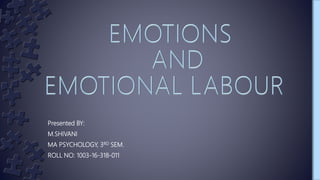Emotions and Emotional Labor
•Als PPTX, PDF herunterladen•
2 gefällt mir•1,326 views
brief description about emotional labour and burnout
Melden
Teilen
Melden
Teilen

Empfohlen
Weitere ähnliche Inhalte
Was ist angesagt?
Was ist angesagt? (20)
Emotions And Moods - Organizational Behavior - Psychology

Emotions And Moods - Organizational Behavior - Psychology
Introduction to Emotions and Moods in Organizational Behavior

Introduction to Emotions and Moods in Organizational Behavior
Ähnlich wie Emotions and Emotional Labor
Ähnlich wie Emotions and Emotional Labor (20)
Effects Of Moods And Emotions | Myth Of Rationality | Emotional Labor | Sourc...

Effects Of Moods And Emotions | Myth Of Rationality | Emotional Labor | Sourc...
A STUDY ON HOW EMOTIONAL DISSONANCE IMPACT WORK EXHAUSTION, JOB SATISFACTION ...

A STUDY ON HOW EMOTIONAL DISSONANCE IMPACT WORK EXHAUSTION, JOB SATISFACTION ...
Emotional labor – an empirical analysis of the correlations of its variables

Emotional labor – an empirical analysis of the correlations of its variables
Organizational Behavior15th EdEmotions and MoodsCopyrigh.docx

Organizational Behavior15th EdEmotions and MoodsCopyrigh.docx
Project Report On Emotion At Work Place -- Dhrubaji Mandal 

Project Report On Emotion At Work Place -- Dhrubaji Mandal
Answer ASAP plz! SECTION B 1- Which of the following statements is cor.docx

Answer ASAP plz! SECTION B 1- Which of the following statements is cor.docx
Emotional Intelligence, Goleman's Theory, Emotional Intelligence in work plac...

Emotional Intelligence, Goleman's Theory, Emotional Intelligence in work plac...
Term paper on "What is the need for emotional intelligence at work?"

Term paper on "What is the need for emotional intelligence at work?"
Kürzlich hochgeladen
Kürzlich hochgeladen (20)
Russian BINDASH Call Girls In Mahipalpur Delhi ☎️9711199012

Russian BINDASH Call Girls In Mahipalpur Delhi ☎️9711199012
💗📲09602870969💕-Royal Escorts in Udaipur Call Girls Service Udaipole-Fateh Sag...

💗📲09602870969💕-Royal Escorts in Udaipur Call Girls Service Udaipole-Fateh Sag...
👉Chandigarh Call Girls 👉9878799926👉Just Call👉Chandigarh Call Girl In Chandiga...

👉Chandigarh Call Girls 👉9878799926👉Just Call👉Chandigarh Call Girl In Chandiga...
7 Oldest Churches in America that will Rejuvenate your Soul.pdf

7 Oldest Churches in America that will Rejuvenate your Soul.pdf
Call Now ☎ 8264348440 !! Call Girls in Govindpuri Escort Service Delhi N.C.R.

Call Now ☎ 8264348440 !! Call Girls in Govindpuri Escort Service Delhi N.C.R.
Dubai Call Girls Phone O525547819 Take+ Call Girls Dubai=

Dubai Call Girls Phone O525547819 Take+ Call Girls Dubai=
👉Chandigarh Call Girls 📞Book Now📞👉 9878799926 👉Zirakpur Call Girl Service No ...

👉Chandigarh Call Girls 📞Book Now📞👉 9878799926 👉Zirakpur Call Girl Service No ...
💞SEXY💞 UDAIPUR ESCORTS 09602870969 CaLL GiRLS in UdAiPuR EsCoRt SeRvIcE💞

💞SEXY💞 UDAIPUR ESCORTS 09602870969 CaLL GiRLS in UdAiPuR EsCoRt SeRvIcE💞
Fun Call Girls In Yamunanagar 08168329307 Jagadhri Escort Services

Fun Call Girls In Yamunanagar 08168329307 Jagadhri Escort Services
Call Girls in Bangalore Nisha 💋9136956627 Bangalore Call Girls

Call Girls in Bangalore Nisha 💋9136956627 Bangalore Call Girls
Zirakpur Call Girls👧 Book Now📱8146719683 📞👉Mohali Call Girl Service No Advanc...

Zirakpur Call Girls👧 Book Now📱8146719683 📞👉Mohali Call Girl Service No Advanc...
Hire 💕 8617697112 Pulwama Call Girls Service Call Girls Agency

Hire 💕 8617697112 Pulwama Call Girls Service Call Girls Agency
WhatsApp 📞 8448380779 ✅Call Girls In Bhangel Sector 102 ( Noida)

WhatsApp 📞 8448380779 ✅Call Girls In Bhangel Sector 102 ( Noida)
💕COD Call Girls In Kurukshetra 08168329307 Pehowa Escort Service

💕COD Call Girls In Kurukshetra 08168329307 Pehowa Escort Service
Chandigarh Escorts Service 📞9915851334📞 Just📲 Call Rajveer Chandigarh Call Gi...

Chandigarh Escorts Service 📞9915851334📞 Just📲 Call Rajveer Chandigarh Call Gi...
Chandigarh Escort Service 📞9878281761📞 Just📲 Call Navi Chandigarh Call Girls ...

Chandigarh Escort Service 📞9878281761📞 Just📲 Call Navi Chandigarh Call Girls ...
Call Girls In Goa 7028418221 Call Girls In Colva Beach Escorts Service

Call Girls In Goa 7028418221 Call Girls In Colva Beach Escorts Service
Jumeirah Call Girls Dubai Concupis O528786472 Dubai Call Girls In Bur Dubai N...

Jumeirah Call Girls Dubai Concupis O528786472 Dubai Call Girls In Bur Dubai N...
Call girls in Vashi Services : 9167673311 Free Delivery 24x7 at Your Doorstep

Call girls in Vashi Services : 9167673311 Free Delivery 24x7 at Your Doorstep
New Call Girls In Panipat 08168329307 Shamli Israna Escorts Service

New Call Girls In Panipat 08168329307 Shamli Israna Escorts Service
Emotions and Emotional Labor
- 1. Presented BY: M.SHIVANI MA PSYCHOLOGY, 3RD SEM. ROLL NO: 1003-16-318-011
- 5. A situation in which an employee expresses organizationally desired emotions during interpersonal transactions at work. › It causes Emotional dissonance – Inconsistencies between the emotions people feel and the emotions they project.
- 6. Felt emotions – emotions that are an individual’s actual emotions. Displayed emotions – emotions that are those that the organization requires workers to show and considers appropriate in a given job.
- 8. Displaying fake emotions requires us to suppress real ones, which can be done in two ways: Surface acting is hiding inner feelings and forgoing emotional expressions in response to display rules Deep acting is trying to modify our true inner feelings based on display rules.
- 11. › Burnout is a state of chronic stress that leads to: physical and emotional exhaustion. cynicism and detachment. feelings of ineffectiveness and lack of accomplishment. › Burnout consists of three interrelated parts: emotional exhaustion, depersonalization, and diminished personal accomplishment.
- 12. Emotional exhaustion is a chronic state of physical and emotional depletion that results from excessive job and/or personal demands and continuous stress. Signs: -Chronic fatigue. -Insomnia. -Forgetfulness/impaired concentration and attention -Physical symptoms. -Increased illness. -Loss of appetite. -Anxiety.
- 13. Depersonalization Depersonalization is an altered state of self- awareness and identity that results in a feeling of dissociation, or separation, from oneself, one’s surroundings, or both. Signs: -Loss of enjoyment -Pessimism. -Isolation. -Detachment.
- 14. Diminished personal accomplishment Signs: - Feelings of apathy and hopelessness - Increased irritability - Lack of productivity and poor performance
- 15. › Keep expectations realistic › Reducing workload › Relax at work › Take allocated lunch breaks › Consider a career break › Develop and maintain interests outside of work › Using full holiday entitlement
- 16. THANK YOU!